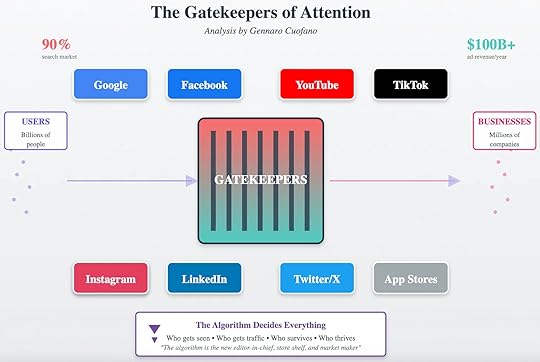The Gatekeepers of Attention

Every business today is in the attention business. Whether you’re a global brand or a local startup, growth depends on being seen, clicked, and remembered. But the path from user to business is not open—it passes through a small set of gatekeepers.
Google controls 90% of search.Facebook, Instagram, and LinkedIn own professional and social discovery.YouTube dominates video.TikTok rewired cultural relevance for an entire generation.App stores decide which digital products even get shelf space.These platforms sit between billions of users and millions of businesses, capturing more than $100 billion a year in advertising revenue for the privilege.
Algorithms as Market MakersGatekeeping isn’t just about access. It’s about algorithms.
Algorithms decide who gets seen.Algorithms decide who gets traffic.Algorithms decide who survives—and who thrives.The editor-in-chief, the store shelf, and the market maker have collapsed into a single black box. If the algorithm favors you, growth is exponential. If not, you vanish into obscurity.
As one founder put it:
The Two-Sided Dependency“Distribution is no longer about merit—it’s about the feed.”
These gatekeepers create a two-sided market dynamic:
UsersBillions of people spend their daily attention inside these platforms.The feed simplifies the world into endless scrolls, swipes, and suggested links.BusinessesMillions of companies depend on visibility within those feeds.Entire industries—from media to e-commerce—are shaped by algorithmic exposure.The result is a massive dependency lock-in: businesses can’t avoid gatekeepers, and users rarely leave them.
The Hidden Cost of AttentionBusinesses often underestimate the hidden costs of depending on gatekeepers:
Rising Rents: As organic reach declines, paid reach becomes the only reliable path.Opaque Rules: Algorithm shifts can erase traffic overnight without explanation.Winner-Takes-All Dynamics: A handful of creators, brands, or apps capture outsized visibility, while the rest compete for scraps.Platform Risk: A ban, suspension, or ranking penalty can destroy years of accumulated audience.Attention comes with a toll—and the toll is rising.
Why Gatekeepers WinThree structural advantages ensure gatekeepers remain entrenched:
Network EffectsMore users create more data, which improves algorithms, which attracts more users.Each additional participant strengthens the moat.Algorithmic PowerAlgorithms don’t just reflect attention—they manufacture it.By controlling ranking and recommendation, gatekeepers engineer demand flows.Default BehaviorsUsers don’t “choose” discovery—they follow defaults.Google is the homepage. TikTok is the downtime filler. LinkedIn is the career hub.Gatekeeping works not because users are forced—but because defaults shape reality.
The Business Model of GatekeepingThe logic of the model is simple:
Users provide attention and behavioral data.Algorithms transform that data into ranked feeds.Businesses pay to insert themselves into those feeds.This creates a self-reinforcing cycle:
More users mean more data.Better targeting increases ad performance.Higher ROI draws more business spend.The cycle explains why digital advertising is not just resilient but dominant—even in downturns.
Cracks in the ModelBut cracks are emerging:
User Fatigue: Younger generations distrust advertising and seek authenticity.Regulation: Antitrust scrutiny in the US and EU is targeting gatekeeper dominance.AI Disruption: Conversational agents threaten to disintermediate traditional feeds by collapsing discovery into dialogue.If AI becomes the default discovery layer, gatekeepers risk losing their privileged position as attention brokers.
Strategic Responses for BusinessesFor businesses, the challenge is clear: you cannot ignore gatekeepers, but you also cannot depend solely on them.
1. Diversify DistributionSpread attention bets across multiple platforms.Avoid overexposure to a single algorithm’s whims.2. Build Owned ChannelsNewsletters, podcasts, and communities provide insulation from gatekeeper risk.Direct relationships are the only hedge against algorithmic volatility.3. Play the Feed, but Don’t Depend on ItOptimize for visibility—short-form video, platform-native content—but treat it as rented space.Use it to funnel users into owned assets.4. Experiment with Emerging LayersAI-driven discovery (ChatGPT, Perplexity, Claude) is already shifting user habits.Early movers can establish presence before the new gatekeepers consolidate power.The Key InsightThe battle for attention is not really between businesses. It is between businesses and gatekeepers.
Businesses fight for scraps of algorithmic visibility.Gatekeepers monetize the battlefield itself.The deeper truth: attention is no longer a market—it is a managed commodity.
And in a managed commodity market, the only way to win long-term is to either:
Become a gatekeeper.Or escape their control by building something they can’t algorithmically tax.Closing ThoughtThe internet was once imagined as a decentralized frontier. In reality, it has condensed into a handful of gatekeepers of attention.
They decide who gets seen, who grows, and who fades. Their algorithms are invisible, but their impact is total.
For businesses, the challenge is not just to capture attention—it is to navigate the algorithmic choke points that control it.

The post The Gatekeepers of Attention appeared first on FourWeekMBA.



